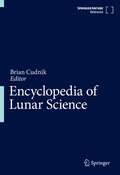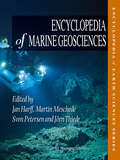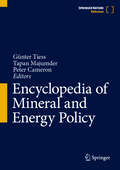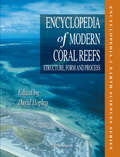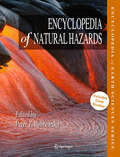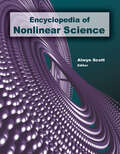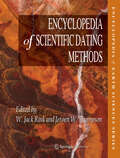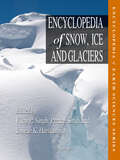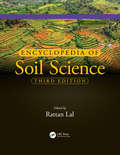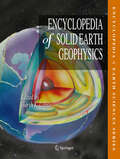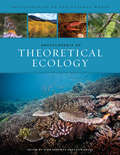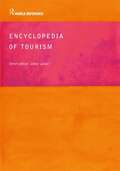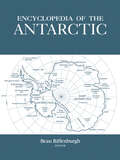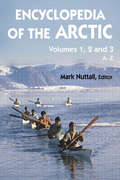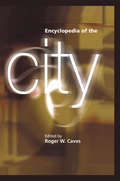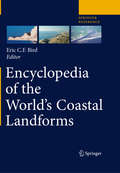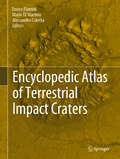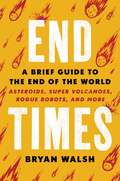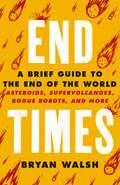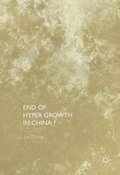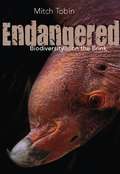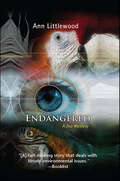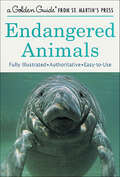- Table View
- List View
Encyclopedia of Lunar Science
by Brian CudnikThe Encyclopedia of Lunar Science includes the latest topical data, definitions, and explanations of the many and varied facets of lunar science. This is a very useful reference work for a broad audience, not limited to the professional lunar scientist: general astronomers, researchers, theoreticians, practitioners, graduate students, undergraduate students, and astrophysicists as well as geologists and engineers. The title includes all current areas of lunar science, with the topical entries being established tertiary literature. The work is technically suitable to most advanced undergraduate and graduate students. The articles include topics of varying technical levels so that the top scientists of the field find this work a benefit as well as the graduate students and the budding lunar scientists. A few examples of topical areas are as follows: Basaltic Volcanism, Lunar Chemistry, Time and Motion Coordinates, Cosmic Weathering through Meteoritic Impact, Environment, Geology, Geologic History, Impacts and Impact Processes, Lunar Surface Processes, Origin and Evolution Theories, Regolith, Stratigraphy, Tectonic Activity, Topography, Weathering through ionizing radiation from the solar wind, solar flares, and cosmic rays.
Encyclopedia of Marine Geosciences
by Jan Harff Martin Meschede Sven Petersen Jörn ThiedeGlobally growing demand of energy and mineral resources, reliable future projection of climate processes and the protection of coasts to mitigate the threats of disasters and hazards require a comprehensive understanding of the structure, ongoing processes and genesis of the marine geosphere. Beyond the "classical" research fields in marine geology in current time more general concepts have been evolved integrating marine geophysics, hydrography, marine biology, climatology and ecology. As an umbrella the term "marine geosciences" has been broadly accepted for this new complex field of research and the solutions of practical tasks in the marine realm. The "Encyclopedia of Marine Geosciences" comprises the current knowledge in marine geosciences whereby not only basic but also applied and technical sciences are covered. Through this concept a broad scale of users in the field of marine sciences and techniques is addressed from students and scholars in academia to engineers and decision makers in industry and politics.
Encyclopedia of Mineral and Energy Policy
by Peter Cameron Günter Tiess Tapan MajumderThis Encyclopedia provides a cutting-edge, up-to-date reference source on mineral and energy policies around the world. It offers information on GDP, population, investment scenarios and current environmental regulations in over one hundred thirty countries from 13 geographic regions around the world. It covers topics such as geo-conservation, deep mining technology as well as rare earth, green technology and international organizations that are actively involved in minerals and energy through exploration, arbitration, marketing and investment. Topical entries are presented alphabetically with extensive cross-referencing to ensure user-friendly reading. This Encyclopedia presents the work of more than 20 section editors and more than 100 international experts in the fields of mineral and energy policies. It is designed as a essential resource for researchers, students, libraries, industry, governments, and international organizations and presents a wealth of insights and guidance for corporate planning regarding exploration and financial investments, as well as for venture capitalist and international funding bodies. As such, it provides an indispensable point of reference for future research on mineral and energy policy.
Encyclopedia of Modern Coral Reefs
by Peter Davies Colin Woodroffe David Hopley Eberhard Gischler Guy Cabioch † I. G. Macintyre Rachel Wood Terry DoneCoral reefs are the largest landforms built by plants and animals. Their study therefore incorporates a wide range of disciplines. This encyclopedia approaches coral reefs from an earth science perspective, concentrating especially on modern reefs. Currently coral reefs are under high stress, most prominently from climate change with changes to water temperature, sea level and ocean acidification particularly damaging. Modern reefs have evolved through the massive environmental changes of the Quaternary with long periods of exposure during glacially lowered sea level periods and short periods of interglacial growth. The entries in this encyclopedia condense the large amount of work carried out since Charles Darwin first attempted to understand reef evolution. Leading authorities from many countries have contributed to the entries covering areas of geology, geography and ecology, providing comprehensive access to the most up-to-date research on the structure, form and processes operating on Quaternary coral reefs.
Encyclopedia of Natural Hazards
by H. Jay Melosh Paul Slovic Peter T. Bobrowsky Tom Beer Norm Catto Bill Mcguire Pedro Basabe Viacheslav Gusiakov Philipp Schmidt-Thomé Farrokh NadimFew subjects have caught the attention of the entire world as much as those dealing with natural hazards. The first decade of this new millennium provides a litany of tragic examples of various hazards that turned into disasters affecting millions of individuals around the globe. The human losses (some 225,000 people) associated with the 2004 Indian Ocean earthquake and tsunami, the economic costs (approximately 200 billion USD) of the 2011 Tohoku Japan earthquake, tsunami and reactor event, and the collective social impacts of human tragedies experienced during Hurricane Katrina in 2005 all provide repetitive reminders that we humans are temporary guests occupying a very active and angry planet. Any examples may have been cited here to stress the point that natural events on Earth may, and often do, lead to disasters and catastrophes when humans place themselves into situations of high risk. Few subjects share the true interdisciplinary dependency that characterizes the field of natural hazards. From geology and geophysics to engineering and emergency response to social psychology and economics, the study of natural hazards draws input from an impressive suite of unique and previously independent specializations. Natural hazards provide a common platform to reduce disciplinary boundaries and facilitate a beneficial synergy in the provision of timely and useful information and action on this critical subject matter. As social norms change regarding the concept of acceptable risk and human migration leads to an explosion in the number of megacities, coastal over-crowding and unmanaged habitation in precarious environments such as mountainous slopes, the vulnerability of people and their susceptibility to natural hazards increases dramatically. Coupled with the concerns of changing climates, escalating recovery costs, a growing divergence between more developed and less developed countries, the subject of natural hazards remains on the forefront of issues that affect all people, nations, and environments all the time. This treatise provides a compendium of critical, timely and very detailed information and essential facts regarding the basic attributes of natural hazards and concomitant disasters. The Encyclopedia of Natural Hazards effectively captures and integrates contributions from an international portfolio of almost 300 specialists whose range of expertise addresses over 330 topics pertinent to the field of natural hazards. Disciplinary barriers are overcome in this comprehensive treatment of the subject matter. Clear illustrations and numerous color images enhance the primary aim to communicate and educate. The inclusion of a series of unique "classic case study" events interspersed throughout the volume provides tangible examples linking concepts, issues, outcomes and solutions. These case studies illustrate different but notable recent, historic and prehistoric events that have shaped the world as we now know it. They provide excellent focal points linking the remaining terms in the volume to the primary field of study. This Encyclopedia of Natural Hazards will remain a standard reference of choice for many years.
Encyclopedia of Nonlinear Science
by Alwyn ScottIn 438 alphabetically-arranged essays, this work provides a useful overview of the core mathematical background for nonlinear science, as well as its applications to key problems in ecology and biological systems, chemical reaction-diffusion problems, geophysics, economics, electrical and mechanical oscillations in engineering systems, lasers and nonlinear optics, fluid mechanics and turbulence, and condensed matter physics, among others.
Encyclopedia of Scientific Dating Methods
by W. Jack Rink Jeroen W. ThompsonThe most comprehensive survey of dating methods in the earth sciences, this book provides a synthesis of physical and chemical bases of dating methods, and the applications of dating methods to the geological sciences, biology, and archaeology.
Encyclopedia of Snow, Ice and Glaciers
by Vijay P. Singh Helgi Björnsson Johannes Oerlemans John F. Shroder Martyn Tranter Michael P. Bishop Pratap Singh Umesh K. Haritashya Wilfried HaeberliThe earth's cryosphere, which includes snow, glaciers, ice caps, ice sheets, ice shelves, sea ice, river and lake ice, and permafrost, contains about 75% of the earth's fresh water. It exists at almost all latitudes, from the tropics to the poles, and plays a vital role in controlling the global climate system. It also provides direct visible evidence of the effect of climate change, and, therefore, requires proper understanding of its complex dynamics. This encyclopedia mainly focuses on the various aspects of snow, ice and glaciers, but also covers other cryospheric branches, and provides up-to-date information and basic concepts on relevant topics. It includes alphabetically arranged and professionally written, comprehensive and authoritative academic articles by well-known international experts in individual fields. The encyclopedia contains a broad spectrum of topics, ranging from the atmospheric processes responsible for snow formation; transformation of snow to ice and changes in their properties; classification of ice and glaciers and their worldwide distribution; glaciation and ice ages; glacier dynamics; glacier surface and subsurface characteristics; geomorphic processes and landscape formation; hydrology and sedimentary systems; permafrost degradation; hazards caused by cryospheric changes; and trends of glacier retreat on the global scale along with the impact of climate change. This book can serve as a source of reference at the undergraduate and graduate level and help to better understand snow, ice and glaciers. It will also be an indispensable tool containing specialized literature for geologists, geographers, climatologists, hydrologists, and water resources engineers; as well as for those who are engaged in the practice of agricultural and civil engineering, earth sciences, environmental sciences and engineering, ecosystem management, and other relevant subjects.
Encyclopedia of Soil Science
by Rattan LalNew and Improved Global Edition: Three-Volume Set A ready reference addressing a multitude of soil and soil management concerns, the highly anticipated and widely expanded third edition of Encyclopedia of Soil Science now spans three volumes and covers ground on a global scale. A definitive guide designed for both coursework and self-study, this latest version describes every branch of soil science and delves into trans-disciplinary issues that focus on inter-connectivity or the nexus approach. For Soil Scientists, Crop Scientists, Plant Scientists and More A host of contributors from around the world weigh in on underlying themes relevant to natural and agricultural ecosystems. Factoring in a rapidly changing climate and a vastly growing population, they sound off on topics that include soil degradation, climate change, soil carbon sequestration, food and nutritional security, hidden hunger, water quality, non-point source pollution, micronutrients, and elemental transformations. New in the Third Edition: Contains over 600 entries Offers global geographical and thematic coverage Entries peer reviewed by subject experts Addresses current issues of global significance Encyclopedia of Soil Science, Third Edition: Three Volume Set expertly explains the science of soil and describes the material in terms that are easily accessible to researchers, students, academicians, policy makers, and laymen alike. Also Available OnlineThis Taylor & Francis encyclopedia is also available through online subscription, offering a variety of extra benefits for researchers, students, and librarians, including: Citation tracking and alerts Active reference linking Saved searches and marked lists HTML and PDF format options Contact Taylor and Francis for more information or to inquire about subscription options and print/online combination packages.US: (Tel) 1.888.318.2367; (E-mail) e-reference@taylorandfrancis.comInternational: (Tel) +44 (0) 20 7017 6062; (E-mail) online.sales@tandf.co.uk
Encyclopedia of Solid Earth Geophysics
by Harsh K. Gupta Ajay Manglik Anny Cazenave Eric Robert Engdahl Kalachand Sain Kusumita Arora Rainer Kind Seiya Uyeda Sukanta RoyThe past few decades have witnessed the growth of the Earth Sciences in the pursuit of knowledge and understanding of the planet that we live on. This development addresses the challenging endeavor to enrich human lives with the bounties of Nature as well as to preserve the planet for the generations to come. Solid Earth Geophysics aspires to define and quantify the internal structure and processes of the Earth in terms of the principles of physics and forms the intrinsic framework, which other allied disciplines utilize for more specific investigations. The first edition of the Encyclopedia of Solid Earth Geophysics was published in 1989 by Van Nostrand Reinhold publishing company. More than two decades later, this new volume, edited by Prof. Harsh K. Gupta, represents a thoroughly revised and expanded reference work. It brings together more than 200 articles covering established and new concepts of Geophysics across the various sub-disciplines such as Gravity, Geodesy, Geomagnetism, Seismology, Seismics, Deep Earth Processes, Plate Tectonics, Thermal Domains, Computational Methods, etc. in a systematic and consistent format and standard. It is an authoritative and current reference source with extraordinary width of scope. It draws its unique strength from the expert contributions of editors and authors across the globe. It is designed to serve as a valuable and cherished source of information for current and future generations of professionals.
Encyclopedia of Theoretical Ecology
by Louis Gross Alan HastingsThis major reference is an overview of the current state of theoretical ecology through a series of topical entries centered on both ecological and statistical themes. Coverage ranges across scales--from the physiological, to populations, landscapes, and ecosystems. Entries provide an introduction to broad fields such as Applied Ecology, Behavioral Ecology, Computational Ecology, Ecosystem Ecology, Epidemiology and Epidemic Modeling, Population Ecology, Spatial Ecology and Statistics in Ecology. Others provide greater specificity and depth, including discussions on the Allee effect, ordinary differential equations, and ecosystem services. Descriptions of modern statistical and modeling approaches and how they contributed to advances in theoretical ecology are also included. Succinct, uncompromising, and authoritative--a "must have" for those interested in the use of theory in the ecological sciences.
Encyclopedia of Tourism
by Jafar JafariIn fewer than three hundred years tourism has become a global service industry of great economic, cultural and political importance. Published to critical acclaim, the Encyclopedia of Tourism - now available as a Routledge World Reference title - is the definitive one-volume reference source to this challenging multisectoral industry and multi disciplinary field of study. Comprising over one thousand entries, this volume has been written by an international team of contributors to provide a comprehensive guide to both the manifest and hidden dimensions of tourism. It explores the wide range of definitions, concepts, perspectives and institutions and includes: comprehensive coverage of key issues and concepts definitions of all terms and acronyms entries on the significant institutions, associations and journals in the field country-specific tourism profiles, from Greece to Japan and Kenya to Peru thorough analysis of the trends and patterns of tourism development and growth. The extensive cross-referencing and comprehensive index will assist the reader in making links between the diverse aspects of tourism studies, and the suggestions for further reading are invaluable.
Encyclopedia of the Antarctic
by Beau RiffenburghThe Antarctic is unique, geographically, politically, and scientifically. It is the most remote, hostile, and dangerous continent, while at the same time it is the most pristine and least developed. Antarctica is the only major part of the Earth's landmass not directly governed by one nation, but under the control of a Treaty, with a multitude of acceding nations. The Encyclopedia of the Antarctic brings together large quantities of information on the wide variety of factors, issues and individuals influencing and relating to the Antarctic. No comparable book currently exists for this region.The Encyclopedia of the Antarctic discusses scientific activities and topics, but the 'human element' is also a significant part of the work, with entries on history, politics, legal issues, national research programs, scientific bases, historic huts, the United Nation's 'Question of Antarctica,' compliance with the Environmental Protocol, and tourism.
Encyclopedia of the Arctic
by Mark NuttallWith detailed essays on the Arctic's environment, wildlife, climate, history, exploration, resources, economics, politics, indigenous cultures and languages, conservation initiatives and more, this Encyclopedia is the only major work and comprehensive reference on this vast, complex, changing, and increasingly important part of the globe. Including 305 maps.This Encyclopedia is not only an interdisciplinary work of reference for all those involved in teaching or researching Arctic issues, but a fascinating and comprehensive resource for residents of the Arctic, and all those concerned with global environmental issues, sustainability, science, and human interactions with the environment.
Encyclopedia of the City
by Roger W. CavesThe Encyclopedia of the City focuses on the key topics encountered by undergraduates and scholars in urban studies and allied fields. Contributors include major theoreticians and practitioners, and on other individuals, groups, and organizations which study the city or practice in a field that directly or indirectly affects the city, the Encyclopedia necessarily adopts an interdisciplinary and multidisciplinary perspective. A solid but also provocative starting point for wider exploration of the city, this is a first-class work of reference that will be an essential resource for independent study as well as a useful aid in teaching.
Encyclopedia of the World's Coastal Landforms
by Eric BirdThis unique richly-illustrated account of the landforms and geology of the world's coasts, presented in a country-by-country (state-by-state) sequence, assembles a vast amount of data and images of an endangered and increasingly populated and developed landform. An international panel of 138 coastal experts provides information on "what is where" on each sector of coast, together with explanations of the landforms, their evolution and the changes taking place on them. As well as providing details on the coastal features of each country (state or county) the compendium can be used to determine the extent of particular features along the world's coasts and to investigate comparisons and contrasts between various world regions. With more than 1440 color illustrations and photos, it is particularly useful as a source of information prior to researching or just visiting a sector of coast. References are provided to the current literature on coastal evolution and coastline changes.
Encyclopedic Atlas of Terrestrial Impact Craters
by Enrico Flamini Mario Di Martino Alessandro ColettaThis comprehensive atlas explains the genesis and evolution of impact known craters on Earth, presenting a wealth of radar images from the Italian COSMO-SkyMed satellites that were acquired at the same frequency, spatial resolution, operating mode, and illumination, allowing excellent comparison of different impact structures. It also discusses in detail the processes that have hidden or erased terrestrial impact craters, and clearly explains the basic principles of remote sensing and the COSMO-SkyMed system and radar instruments. Also, the optical satellite remote sensing technique used to produce the optical images is described. The main section documents each of the exposed craters officially recognized as caused by meteoritic impact, presenting a table with the COSMO-SkyMed radar image and, where available, a Sentinel optical image and a photograph taken in situ. A short accompanying text reports the location, context, geographical coordinates, and other ancillary information to support future researches.
End Times: A Brief Guide to the End of the World
by Bryan WalshWhat is going to cause our extinction?How can we save ourselves and our future?End Times answers the most important questions facing humankindEnd Times is a compelling work of skilled reportage that peels back the layers of complexity around the unthinkable-and inevitable-end of humankind. From asteroids and artificial intelligence to volcanic supereruption to nuclear war, 15-year veteran science reporter and TIME editor Bryan Walsh provides a stunning panoramic view of the most catastrophic threats to the human race.In End Times, Walsh examines threats that emerge from nature and those of our own making: asteroids, supervolcanoes, nuclear war, climate change, disease pandemics, biotechnology, artificial intelligence, and extraterrestrial intelligence. Walsh details the true probability of these world-ending catastrophes, the impact on our lives were they to happen, and the best strategies for saving ourselves, all pulled from his rigorous and deeply thoughtful reporting and research.Walsh goes into the room with the men and women whose job it is to imagine the unimaginable. He includes interviews with those on the front lines of prevention, actively working to head off existential threats in biotechnology labs and government hubs. Guided by Walsh's evocative, page-turning prose, we follow scientific stars like the asteroid hunters at NASA and the disease detectives on the trail of the next killer virus.Walsh explores the danger of apocalypse in all forms. In the end, it will be the depth of our knowledge, the height of our imagination, and our sheer will to survive that will decide the future.
End Times: Asteroids, Supervolcanoes, Plagues and More
by Bryan WalshNewsweek and Bloomberg popular science and investigative journalist Bryan Walsh explores the history of extinction and offers a cutting-edge examination of existential risk, the dangerous mistakes we have yet to pay for, and concrete steps we can take to protect ourselves and future-proof our civilization.What is going to cause our extinction?How can we save ourselves and our future?End Times answers the most important questions facing humankindEnd Times is a compelling work of skilled reportage that peels back the layers of complexity around the unthinkable-and inevitable-end of humankind. From asteroids and artificial intelligence to volcanic supereruption to nuclear war, 15-year veteran science reporter and TIME editor Bryan Walsh provides a stunning panoramic view of the most catastrophic threats to the human race.In End Times, Walsh examines threats that emerge from nature and those of our own making: asteroids, supervolcanoes, nuclear war, climate change, disease pandemics, biotechnology, artificial intelligence, and extraterrestrial intelligence. Walsh details the true probability of these world-ending catastrophes, the impact on our lives were they to happen, and the best strategies for saving ourselves, all pulled from his rigorous and deeply thoughtful reporting and research.Walsh goes into the room with the men and women whose job it is to imagine the unimaginable. He includes interviews with those on the front lines of prevention, actively working to head off existential threats in biotechnology labs and government hubs. Guided by Walsh's evocative, page-turning prose, we follow scientific stars like the asteroid hunters at NASA and the disease detectives on the trail of the next killer virus.Walsh explores the danger of apocalypse in all forms. In the end, it will be the depth of our knowledge, the height of our imagination, and our sheer will to survive that will decide the future.
End of Hyper Growth in China?
by Jun ZhangIn this book, Dr. Jun Zhang rebuts the widely-held view that Chinese economic growth is unsustainable due to low consumption and a reliance on exports and enormous fixed-asset investments. Though many believe this "structural imbalance" of the Chinese economy will become a serious problem in the long run, Zhang holds a bullish long-term outlook owing to China's long-term economic development. For Zhang, China's structural problems are greatly exaggerated and certain structures, such as regional governing entities, ensure that China will not face the same economic issues that Japan encountered. Through regional competition, regional governments will persevere; Zhang predicts that China will overtake the US as a superpower. Zhang concludes by acknowledging the real dangers facing China's economy, and offering advice on the reforms needed to ensure continued growth.
Endangered
by Mitch TobinSince 1973, the Endangered Species Act has served as our nation's legislative ark for imperiled wildlife. But our toughest and most controversial environmental law has only recovered a handful of the more than 1,300 species under its protection. In Endangered, award-winning journalist Mitch Tobin uses firsthand accounts to show why so many species are at risk of extinction.For nearly seven years, Tobin reported from the front lines of Endangered Species Act battles. He crisscrossed the Southwest-our hottest, driest, fastest-growing region-in search of wildlife driven to the brink of extinction and solutions to the crisis. Tobin discovered that this region, with its urban sprawl, wasteful water use, and vulnerability to climate change, provides a snapshot of the issues facing species throughout the world.Yet in one of the continent's hot spots for biodiversity, Tobin also found compelling examples of collaboration. With these examples in mind, he advocates for a set of innovative policies that can preserve the species and wild places that sustain us all.Mitch Tobin worked as a journalist from 1999 to 2006, covering wildlife, wildfires, and other environmental issues for the Tucson Citizen, Arizona Daily Star, and High Country News. Endangered grew out of Tobin's yearlong series on Arizona's endangered species, which was a finalist for the John B. Oakes Award for Distinguished Environmental Journalism. His work was honored in the Best of the West competition and received first prizes from the Arizona Press Club and Arizona Associated Press Managing Editors. Today, Tobin serves as a consultant to leading conservation groups and foundations.
Endangered (Zoo Mysteries)
by Ann LittlewoodWhen a drug bust reveals exotic animals at a marijuana grow site, zookeeper Iris Oakley and a colleague ride to the rescue in the zoo's van. But instead of pets they find smuggled parrots and tortoises destined for sale to unscrupulous or unsuspecting collectors. Iris also discovers a woman who escaped the bust—dead.The murder and the drug ops are the cops' problem, but Iris is determined to break the criminal pipeline that snatches rare animals from the wild and leaves them neglected in old barns. The zoo's facilities are full, and Iris ends up with two macaws shrieking in her basement. Next, brothers from the busted family, both murder suspects, invade her home, demanding information they think their father passed on as he, too, died at the scene.Iris flees with her child, but soon realizes she must be on the offensive. People she counts on are not who they claim to be. Sorting through baffling clues and tripping over secrets old and new, Iris soon learns that everyone has an agenda. And at least one of them is deadly....
Endangered Animals (Golden Guides from St. Martin's Press)
by George S. FichterThis eBook is best viewed on a color device.Wildlife is in danger everywhere. In this timely look at the plight of endangered animals, you will find:-A survey of hundreds of animal species that are in trouble-Descriptions of the many causes of endangerment and the controversies surrounding current laws-Fascinating stories about the efforts of people to rescue species and restore harmony and balance in nature-More than a hundred dramatic full-color illustrationsHere is a valuable resource for nature lovers-for anyone, in fact, who is concerned with the fate of animals and the future of life on this planet.
Endangered Animals of Thailand
by Stephen R. HumphreyThis work presents the state of knowledge on the endangered and threatened species of Thailand. Its pragmatic purpose is to improve Thailand’s future by providing access to technical guidance for planning development projects or other land-use changes. This information also should stimulate naturalists, professional biologists, or anyone who wishes to learn about the status of animals in Thailand. Which species are now on the brink of extinction from Thailand, and why? How can the Thai people reorganize themselves to reverse the course of destruction? Can ways be found for both the people and the rest of the fauna to prosper? Another purpose is to present a case study of the effects of longterm development for human use on the biological diversity of a tropical country.
Endangered Economies: How the Neglect of Nature Threatens Our Prosperity
by Geoffrey HealIn the decades since Geoffrey Heal began his field-defining work in environmental economics, one central question has animated his research: "Can we save our environment and grow our economy?" This issue has become only more urgent in recent years with the threat of climate change, the accelerating loss of ecosystems, and the rapid industrialization of the developing world. Reflecting on a lifetime of experience not only as a leading voice in the field, but as a green entrepreneur, activist, and advisor to governments and global organizations, Heal clearly and passionately demonstrates that the only way to achieve long-term economic growth is to protect our environment.Writing both to those conversant in economics and to those encountering these ideas for the first time, Heal begins with familiar concepts, like the tragedy of the commons and unregulated pollution, to demonstrate the underlying tensions that have compromised our planet, damaging and in many cases devastating our natural world. Such destruction has dire consequences not only for us and the environment but also for businesses, which often vastly underestimate their reliance on unpriced natural benefits like pollination, the water cycle, marine and forest ecosystems, and more. After painting a stark and unsettling picture of our current quandary, Heal outlines simple solutions that have already proven effective in conserving nature and boosting economic growth. In order to ensure a prosperous future for humanity, we must understand how environment and economy interact and how they can work in harmony-lest we permanently harm both.
